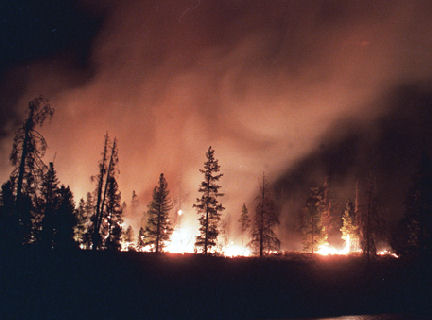Major forest fires in the western United States have become more frequent and destructive over the past 2 decades. The trend has occurred in step with rising average temperatures in the region.

“Climate change in the West is a reality,” says Thomas Swetnam of the University of Arizona in Tucson. “Now, we’re starting to see the effects.”
Earlier spring snowmelts, which kick off longer fire seasons, account for the trend, he says. The melt’s timing influences how parched—and therefore how vulnerable to fire—the landscape gets later in the year.
Western snow packs now typically melt a week to a month earlier than they did half a century ago, recent studies have shown.
The northern Rockies have borne the brunt of the shift in fire patterns. In 1988, midsummer infernos torched 600,000 hectares in and around Yellowstone National Park; 25,000 firefighters battled the blaze, which continued until that winter’s first snows fell.
About three-fifths of the largest U.S. wildfires since then have struck the same region. Government agencies spend up to $1.7 billion per year on wildfire control, and annual damages sometimes exceed $1 billion.
To understand the factors behind this mounting hazard, Swetnam and three colleagues examined fire, weather, and snowmelt data from 1970 to 2003.
For each year, the number and total area of major forest fires closely correlated with average spring and summer temperatures and with the date on which snowmelt peaked, reports the team, which was led by Anthony Westerling of the Scripps Institution of Oceanography in La Jolla, Calif.
Since 1987, fires have burned 6.5 times as much area per year as they did between 1970 and 1986, the researchers report in the Aug. 18 Science. The average temperature increased 0.87°C between the two periods, and the average length of the fire season grew by 78 days.
“Warmer temperatures seem to be increasing the duration and intensity of the wildfire season in the western United States,” comments ecologist Steven Running of the University of Montana in Missoula.
Climate scientists project increases in summer temperatures of between 2°C and 5°C by about midcentury in western North America. Last year, researchers estimated that Canadian wildfires will double in annual area burned during the next century. “Similar increases seem likely for the western United States,” Running says.
Fire-control efforts need to be adjusted accordingly, in recognition that occasional major fires, like earthquakes, are unavoidable, says Constance I. Millar of the U.S. Forest Service in Albany, Calif. Until now, she says, the recent upswing in major fires has generally been blamed on past policies of suppressing small fires and on animal-grazing practices that cause combustible materials to accumulate in and near forests. Newer policies, including the Bush administration’s “Healthy Forests” initiative, have emphasized clearing brush, trees, and other fuels near vulnerable areas.
But the new data, Millar says, “point a finger at warming, rather than grazing or a history of fire suppression,” as a cause the trend toward increasingly severe forest fires.
“This trend will not go away unless the trend in temperature turns,” she says.
Controlling today’s forest fires could mitigate tomorrow’s fire threat, because trees absorb atmosphere-warming carbon dioxide, she says. “If we can keep the trees on the stump, then [they’re] sponging up carbon from the atmosphere.”







